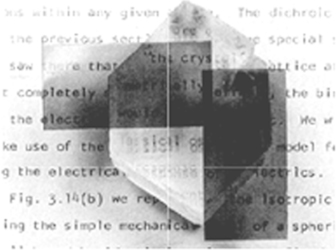1
Double Refraction
The operation of liquid crystal displays is founded on the phenomenon of the double refraction of light as first recorded in Denmark by Erasmus Bartholinus in 1670. A piece of translucent calcite apparently divides incident light into two streams, producing a double image. This is depicted in Figure 1.1, as shown by the offset of the word “calcite.” At about the same time in the Netherlands, Christian Huygens discovered that the light rays through the calcite could be extinguished by passing them through a second piece of calcite if that piece were rotated about the direction of the ray; this is depicted in Figure 1.2. This may be observed by taking two pairs of polarizing sunglasses and rotating them relative to each other.
One hundred and thirty-eight years later, in 1808, a protégé of the famous French mathematician Fourier, Etienne Louis Malus, observed that light reflected from a window, when passing through a piece of calcite also would change intensity as the calcite was rotated, apparently showing that reflected light was also altered in some way. The intensity of the light ...



